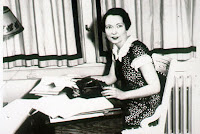Had she not been struck down by a drunk driver, Margaret Mitchell Marsh would have been 108 today. Born in 1900 in Atlanta (where else?) to a family well-defined by its number of soldiers and patriots, young Margaret (“Peggy”) grew up immersed in stories of the Civil War. Not surprising, her upbringing was not too dissimilar to that of her famous heroine, Scarlett O’Hara. Her free-spirited intelligence set her apart from fellow debutantes, and by the early 1920’s she was considered a “headstrong flapper”.
While courted by both ex-football player Berrien “Red” Upshaw and newspaperman John Marsh, she married Upshaw but found him to be inadequate support so soon took a job as a writer working for Marsh at the Atlanta Journal. She was paid $25.00 per week as one of the first woman columnists at the South’s largest newspaper. Her marriage didn’t last long; Upshaw was found to be a bootlegger, and she divorced him in 1924. In 1925, she married Marsh.
It is said that she began writing her famous, Pulitzer prize-winning novel while laid up with a broken ankle. Having exhausted all of the historical books her husband brought home to amuse her, Peggy set up a Remington typewriter and took to heart Marsh’s suggestion that she write her own book.
While she always claimed that Gone With the Wind was entirely fictional, historians have since discovered a number of undeniable parallels with actual people living before and during Mitchell’s lifetime. Surely the death of Scarlett’s mother from typhoid matches Mitchell’s own mother’s passing, a result of an epidemic flu. More enlightening is the discovery by Dr. E. Lee Spence of ties between fictional Rhett Butler and real-life blockade runner George Alfred Trenholm. It would seem that Ms. Mitchell based Butler’s character quite specifically on Trenholm. (See Spence’s book: Treasures of the Confederate Coast: The “Real Rhett Butler” and Other Revelations for more on this astonishing discovery, which Life magazine called “overwhelming evidence.”)
Peggy was a reluctant author, hiding her manuscript from all except her husband. It was only after a friend commented that it was unimaginable that “anyone as silly as Peggy” could write a book that she gave the novel to MacMillan talent scout Harold Latham, who bought a second suitcase with which to transport the massive manuscript back to New York. Mitchell was immediately regretful and sent a telegram to Latham, asking for the book back. However, the editor had no intention of returning it, having determined it had the potential to be the blockbuster it later became.
Some stats: It took her 9 years to write, both typed and hen-scratched onto heaps of scrap paper;
The book was released in June, 1936; by early 1949, it was announced that the book had sold 8 million copies (Mitchell had hopes of selling 5,000 copies.)
David O. Selznick paid her $50,000 for the movie rights;
The ending of GWTW was written first, Mitchell writing her way back toward the beginning. The first chapter had not been written when she submitted to MacMillan;
Mitchell hated publicity, and wrote: “My time is not my own. It has not been my own since ‘Gone With the Wind’ was published. The very fact that since 1936 I have never had the time to sit down –to my typewriter and write—or try to write—another book will give you some indication of what I mean.”
She added that “being the author of ‘Gone With the Wind’ is a full-time job, and most days it is an overtime job filling engagements and meeting visitors. In addition, I am giving all the time I can to war activities and future commitments in this field which will take me out of the city.” Although the fame disrupted her life, it brought her an estimated $1,000,000 in book royalties, movie payments and other returns in less than four years.
The off-duty taxi driver who struck Mitchell had 23 prior traffic violations on record. He was charged with drunken driving, speeding, and driving on the wrong side of the street. Gov. Herman Talmadge ordered the flag over the State Capitol lowered to half-staff until after the funeral.
